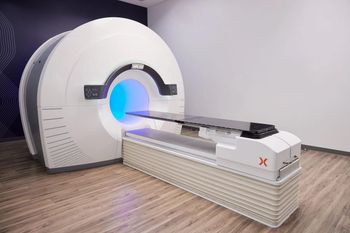
MRI/CT Imaging for Axillary Lymph Nodes: What a New Breast Cancer Study Reveals
The combination of magnetic resonance imaging (MRI) and computed tomography (CT) had a 63.83 percent sensitivity rate for tumor-infiltrated axillary lymph nodes in patients with breast cancer in comparison to a 36.11 percent sensitivity rate for the combination of mammography and sonography.
Emerging research suggests the combination of magnetic resonance imaging (MRI) and computed tomography (CT) may significantly improve axillary lymph node staging in patients with breast cancer.
In a new study,
The study authors said the combination of all four modalities resulted in a 68.89 percent sensitivity rate for tumor-infiltrated axillary lymph nodes. However, cross-sectional imaging with MRI and CT showed significantly higher sensitivity (63.83 percent) in comparison to a combination of mammography and sonography (36.11 percent).
“The combination of advancing MRI technology and CT staging, both focusing on axillary lymph nodes, could possibly improve sensitivity in the future,” wrote Catharina Bartmann, M.D., who is affiliated with the Department of Obstetrics and Gynaecology at University Hospital in Wurzburg, Germany, and colleagues. “As CT examinations of the chest and the abdomen are the standard staging procedure for (breast cancer) patients with high risk of metastasis formation, this imaging data is already available.”
The combination of sonography, MRI and CT yielded a 68.09 sensitivity rate and the combination of mammography with MRI and CT had a 65.91 sensitivity rate, according to the study. Comparing the sensitivity rates of each imaging modality, the researchers noted that CT had a 51.4 sensitivity rate for detecting positive lymph nodes in comparison to the sensitivity rates for MRI (41.51 percent), sonography (34.56 percent) and mammography (14.60 percent). However, Bartmann and colleagues pointed out that MRI provides the most optimal imaging for detecting tumors smaller than 2 cm.
In regard to study limitations, the researchers noted that the retrospective nature of the study prevented the use of complete imaging techniques for all of the patients in the study. Selection bias is another possible limitation, according to the study authors. Noting that MRI/CT imaging was primarily utilized in patients with additional risk factors, Bartmann and colleagues conceded a higher probability of axillary tumor infiltration on cross-sectional imaging in this subgroup.
Newsletter
Stay at the forefront of radiology with the Diagnostic Imaging newsletter, delivering the latest news, clinical insights, and imaging advancements for today’s radiologists.




























